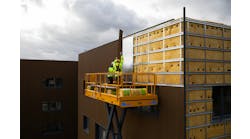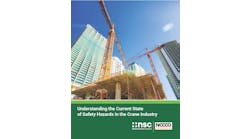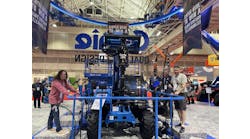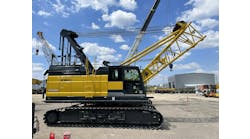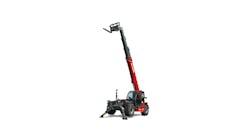RER: Tell us about new technological developments on your equipment?
Ford: We have been working hard to prepare for EPA emissions regulations known collectively as Tier 4 in North America. This will require the re-powering of all of our products with engines larger than 25hp. Previous Tier changes have had little effect on the product, but the Tier 4 changes will require exhaust after-treatment and increased heat rejection. The packaging of the after-treatment and larger radiators will result in some product changes. We also have significant internal and field testing planned to ensure a quality product for our customers.
Shaughnessy: Rental equipment used in construction and technological developments are not necessarily a desired combination. Most customers tell us not to update or refresh our equipment often as it creates obsolete parts, adds to training requirements and costs, and does not necessarily improve quality and reliability. Skyjack has always focused on a core design philosophy that maintains commonality for serviceability over model years as well as across product lines.
Fitchett: Snorkel is in the process of introducing a new control system, which is more responsive for the operator, and critically it is much easier for service engineers to diagnose and rectify any issues. Snorkel’s reputation is built on the reliability and durability of its aerial work platforms, so we are constantly looking at new ways to improve both these key aspects. We have already integrated the new control system into our new S Series of electric slab scissor lifts. Over the coming months, we will continue to roll it out across our product range for internal applications. Our booms remain hard-wired as this is the best solution for boom lifts.
Mouillefarine: Our new technology will focus on being more user-friendly. We have a lot of exciting ideas from an R&D standpoint, but intend to first measure those with the benefits to the customer. Providing a solution that allows an AWP operator to work more efficiently is a key driver for instance. Serviceability of our machines is a very close second target.
Mellott: The introduction of connected asset fleet management tools, like ClearSky, completely transform the way you manage your fleet. With constant visibility of equipment, you can monitor where and how machines are operating, in real time, with remote access to diagnostics and troubleshooting. This helps lower cost of ownership by delivering more run-time, reducing service calls and improving time management.
Christensen: We’re launching a new lift model, called the FS105-Z, which is a combined articulating and telescoping compact lift type with record-setting performance for its category. It will in particular be targeted against outdoor applications, where you have the combination between limited access , large outreach and significant work height. However, it is also equipped with batteries for indoor use, so it can be used indoor as well.
RER: What are some of the trends you expect to see in the coming years in aerial equipment? In booms, scissors, telehandlers and others?
Ford: The Tier 4 engines will have electronic controls in most cases. This will require more advanced electronic controls for machine functions. In addition, there are international standards developing that will require control system changes that can only be solved with embedded microprocessor controls. Terex AWP is working on developing the control systems of the future that meet these requirements and have the robustness for surviving the construction and rental industry environments.
In scissors, specifically, the need has grown for lighter weight machines. The key, however, is to produce machines that are durable and able to withstand jobsite wear and tear, which is why we put such emphasis on building quality products. Our customers still expect the equipment to be of high quality and durability.
In telehandlers, cab comfort has grown in importance as it can provide enhanced jobsite productivity. There is a growing move to large telehandlers especially in the 12-15k range. In addition, interest in hybrid technology as a means of lowering emission and improving fuel economy is gaining ground in the compact market and will eventually migrate to bigger machines.
Shaughnessy: There is a growing trend towards manufacturing equipment that is not only more energy efficient but also contributes to a reduced carbon footprint. One example is to use a higher percentage of recyclable materials to limit environmental impact at the end of the life cycle. Another example would be improving the sustainability of wear items such as oils and tires.
Fitchett: Diversification is the buzz word in the rental industry. The major rental companies are all looking for revenue streams outside of construction. I think this will drive innovation on smaller, compact machines. In particular, we very firmly believe there is a huge, unexplored opportunity for low-level access. Injuries caused by falls from heights of six feet or less cause enormous personal and economic damage in North America. Lightweight “mini” scissorlifts with platform heights of up to 10 feet can really improve productivity and safety.
Mouillefarine: Larger trends will be about more specialization in booms (more specific machines of all kinds) and an increased feeling of safety for telehandlers. More so in 2010 than 2009, survival trends for the aerial equipment business may require players to specialize in certain areas versus being all things to all persons. Some players may withdraw from activities where they are weak.
Mellott: We are working to make an even stronger commitment to the aftermarket and supporting the equipment after the sale. This trend began in 2008 with the launch of JLG Ground Support and continues with the establishment of service providers and improved aftermarket programs designed improve return on investment for our customers.
Christensen: Well, being in a niche field of the industry as the market leader for compact lifts, I have the privilege to observe the market in a different way than producers of so-called main stream products like boom and scissor lifts. I believe that we will see an increased focus on specialty products, being it compact lifts or tall truck mounted lifts. We’ve seen a significant de-fleeting from the rental industry over the past year, and the market is still seeing more supply than demand on the traditional lift products. Consequently, the rental industry must look for new venues for revenue, and I think we will see some change in directions among the aerial rental industry. But, eventually, as always it will equally depend on the suppliers of specialty equipment and their ability to adapt and understand the needs of the rental business, and cater to those needs in a manner where they just don’t act as vendors, but if you like, partners as it will require a closer cooperation.
RER: In terms of the rental market, we hope we may be seeing something of a recovery in the second half of this year and going into 2011. What are your expectations for the economy?
Ford: We have seen some areas of growth in the first half of 2010, but we still have a long way to go to full recovery. We expect limited growth for the rest of 2010, with most customers still using caution into 2011. We will continue to develop new products that will enable us to give our customers innovation and quality as the market recovers.
Shaughnessy: The economy appears to have hit bottom and is preparing for recovery. Recovery in the rental industry typically lags behind movements in the broader economy. We are already seeing improved utilization. We expect this to be followed by price improvement and capital expenditure for replacement equipment and growth. With the fleet downsizing that took place over the past three years, there will be a certain level of replacement buying to help improve the aged fleets. This could come in the form of a more noticeable wave of activity in the spring of 2011, especially in North America where the impact of the recession was more severe.
Fitchett: We’re not out of the woods yet! If you look at the key market indicators for construction activity in particular, there are few signs of any real improvement this year, period. Rental companies are holding onto their cash and until they see some major improvement in utilization, they have no need to invest in new aerials. I expect 2011 will herald the start of the upturn – and when it comes, I think this time it will be a much more gradual upturn than in the past.
Mouillefarine: We are in line with this analysis, assuming a strong confidence in the U.S. economy to recover faster than other areas in the world. Unfortunately in our business and many others; the confidence will only be restored when people become aware and see that all other companies are investing. Then there will be the demands for various machines quickly, from multiple sources, requiring delivery at the same time. Plans are in place for this ramp up, but it remains a difficult item to forecast.
Mellott: We hope that’s the case and are expecting some improvement going into spring of 2011. While we don’t expect a return to 2008 numbers, we expect 2011 to see some gradual recovery.
Christensen: I think we all hope that the small light we all see at the end of the tunnel after the first half of the year truly is the end, and not another oncoming train. I expect the economy to continue to slowly improve over the second half, and we’ve seen strong signals in the market that some level of optimism is back. I do believe the mid-term elections in November will be the deal maker or breaker as far as 2011 goes. Said in non-partisan way, I believe it is necessary to create a better political balance in Congress in order to obtain stability, which will bring the financial players back into the ring.
What types of equipment do you recommend for rental fleets as we go into, hopefully, a recovery? And why?
Ford: As the demand for rental equipment increases, most end users and contractors will want new equipment that is reliable and allows them to get their jobs done accurately and in a timely fashion. It is best to refresh all portions of the rental fleet, such as scissors, telehandlers, booms, AWPs, light towers, etc. Focusing on one or two categories of product will make success a gamble. It is the nature of the rental business that you cannot predict what machine the rental customer will want. It is an on-demand customer-to-rental-business relationship. You need all products to be ready.
Shaughnessy: The strategy for how each rental company handles the recession will dictate their equipment needs during the recovery period. One thing all rental companies will have in common however are continued cost and resource pressures. It will take time to get rental rates back to levels of normalcy, and until bottom lines improve it’s always hard to justify re-staffing branches. Skyjack’s reputation of having the lowest life cycle cost equipment in the market will hopefully appeal to rental companies as they choose which manufacturer to purchase from. Skyjack’s robust and easy-to-service designs, with higher residual values, will help rental companies cope with the continued cost pressures.
Fitchett: Snorkel recently launched the Pop-Up brand of push-around mini-scissors in North America. Pop-Up lifts deliver the productivity and safety benefits of aerial work platforms to an entirely new sector – those professions that are currently reliant on podium towers or stepladders. Pop-Up represents a superb rental opportunity – major rental companies in the U.K. have achieved full payback in little more than a year, with average utilization rates of 90 percent and above. The machines are so highly regarded that some of the largest construction contractors in Britain have now banned the use of stepladders or podiums on their job sites.
Mouillefarine: It is not easy to recommend to customers what to do. The richness of our industry is that actors have different strategies, including the equipment strategy.
If I was to risk a wish, it would be that our customers specialize on their users by segments and gain a better knowledge of their needs, and thus provide the right products and services. We need to help our industry not turn into a commodity business, where all actors have the same machine and everything is about price and availability. According to that, an increased amount of products should be specific to choices of the rental company, to be different from the others.
Mellott: Big booms and higher capacity telehandlers have been the best sellers through the later part of the downturn. We expect sales of these units to grow, partly due to their use in stimulus- and energy-related construction.
Christensen: As commented above, the specialty products offer new segments that so far is undeveloped. Typically the ROI is higher on specialty products, but of course, typically so is the cost.
What are some of the improvements and new developments your customers have been asking for in your equipment?
Ford: Our customers always have wanted the best quality products and service available. We will continue to focus on continuous improvement. Overall our customers expect equipment to be reliable and provide a good ROI, We strive everyday to accomplish this for them.
Shaughnessy: Aside from the “green” products mentioned, customers are asking for new models rather than changes to existing products. They are asking for more and more models to cover niche applications and hopefully cross over with other core products for general applications so that utilization will be more consistent.
Fitchett: Snorkel has a hard-won reputation for producing reliable, robust machines that are built to last. Almost all the customer feedback we get about product development relates to the changing landscape of aerial safety.
Mellott: We are always looking to expand and build on our products, accessories and services to improve productivity and safety for our end-use customers and provide innovative ways to improve return on investment for our channel customers.
Christensen: Aside from the usual desire to get more for less, I think the customers more than before is looking for the best equipment for the job, not just from an application point of view, but also safety point of view. The customers expect that we as vendors look at their needs and from there design our product portfolio. In tough times you often see consolidation mode, i.e. manufacturers are cutting down on number of models in an effort to rationalize the production. While everyone can understand why, in reality it is forcing the customers to so to speak adapt accordingly. In essence it should be the other way around, in particular in a service driven market. So, we try to accommodate our customers by keeping a large product range, which short term may be a little less efficient for the bottom line, but long term we are able to continue to provide optimal solutions. As we all know, the right lift for the right job improves safety, which should be any lift manufacturer’s number one concern.
What are some of the most important regulatory developments – in terms of aerial safety – currently and how do they play into where you are going in your technology?
Ford: Developing markets, such as China and Korea, are beginning to introduce standards. These standards are usually adopted from existing European standards. This is a good thing for the industry. It brings the product safety that is expected in the developed markets.
SIA in conjunction with ARA, AEM and other industry organizations recently introduced a Statement of Best Practices of General Training and Familiarization for Aerial Work Platform Equipment. This provides a frame work that will lead to more informed machine operators and job site safety.
Shaughnessy: In North America, there are no immediate significant developments with respect to regulations regarding Aerial Work Platforms or their use. However, other jurisdictions have made or are making changes to these regulations. In Europe, the latest Machinery Directive, 2006/42/EC, has recently been enacted into law in member states. The harmonized standard that can be used to demonstrate compliance with this directive is EN 280. Korea has recently implemented a new certification requirement based on EN 280 and Australia is in the midst of a similar change, with interim requirements imposed by the regulators until their standard is updated with similar requirements from EN 280.
The technology to achieve compliance with these requirements is not really a particular issue, but for manufacturers, a universal standard for the design and manufacture of these lifts would be desirable to eliminate regional differences in machines. Skyjack is involved in the effort to create an effective ISO standard, that could be acceptable internationally and is also working toward encouraging the ANSI committee to move towards a similar format now, with the goal of converging toward international requirements.
Fitchett: In the U.S., OSHA is beginning to monitor and enforce low level access more closely. Many customers, at the recommendation of inspectors, are requiring anchorage attachments for scissor lifts, even though not required under OSHA regulations and opposed by organizations such as IPAF. This has driven us to consider anchorage attachments as standard on low level access equipment. Although not driven heavily yet through governmental regulations, many insurance companies are recommending the removal of ladders above four feet from many worksites and facilities. This may help to drive the low level access market even faster, as employers look for the most cost effective means to maintain compliance.
Worldwide, the new Australian standard will become effective soon - but it is so closely related to EN280 (the European standard) that I think it will help Snorkel’s global growth. It means we can build more standardized units that comply with a variety of national or regional standards.
Christensen: It is a sensitive subject as regulations are often seen as an obstacle to free enterprise, but when it comes to aerial safety, it is a vital subject. In terms of specific regulatory developments, we still need more strict legislation for the most basic safety issues, such as wearing safety harnesses and fall protection equipment, not to mention proper training requirements. Every year hundreds of fatalities are caused by use of ladders in situations where either a lift or a scaffold should have been used. Some European countries like the Netherlands has over the recent years implemented quite strict legislation as far as the use of ladders, and it will be interesting to see how that plays out in the statistics as far as accidents related to use of ladders. Today the customer has a long range of compact aerial equipment that wasn’t available just five years ago, so I see it more as a natural evolution rather than restrictive regulations only. At the end of the day we all share the same goal – customers and vendors – to create a safer work environment.
What areas of aerial safety are you most concerned with right now and what is your company doing in the safety area?
Ford: Some of the areas related to aerial safety we would like to see improvement from the industry on are:
- Operators receiving proper safety training is always of great importance to the industry as a whole. It’s critical that the operator’s employer ensures that the employee receives all of the necessary safety training as it relates to the proper safe operation of the aerial lift equipment. Employers may already have an internal safety training program, but for those that don’t, Terex AWP has a training program to help a qualified trainer train operators. By simply calling Genie at the toll free number 1-800-536-1800, they can place an order for the safety training kit number 72837, which can be used to supplement any additional safety training information the trainer would use during their training class.
- Notifying the equipment manufacturer of a change of ownership. This is critical to help ensure that the new owner of the equipment will receive any safety related information from the manufacturer.
- Another potential area for concern is the service and maintenance of an aerial lift. If an aerial lift is not properly maintained it could result in the machine malfunctioning. A malfunctioning machine should never be operated. It’s important to remember that performing a pre-operation and function test prior to use will identify any potential issues. If anything is out of the ordinary, the machine should be removed from service immediately and repaired by a qualified technician before being placed back into service.
Shaughnessy: Skyjack is very concerned with proper Operator Training and Familiarization. As such, Skyjack is the most active American Work Platform Training (AWPT) training center in North America. Skyjack is also intimately involved in many industry organizations promoting these fundamentals of operator safety; the Association of Equipment Manufacturers (AEM), the International Powered Access Federation (IPAF), the American Rental Association (ARA) to name a few.
These organizations recently published an industry guideline entitled “Statement of Best Practices of General Training and Familiarization for Aerial Work Platform Equipment”. The impetus of this document can be traced back to the keynote speech of the 2008 APEX exhibition in Maastricht, given by then Skyjack President, Ken McDougall, in which he challenged the industry to be more active with respect to Operator training. This led to an Executive Summit of the major North American renters and manufacturers to discuss the issue, and eventually, through their member organizations, to publish the Best Practices Statement.
As you are also aware, I was recently elected the president of IPAF, and Skyjack was a recipient of the International Awards for Powered Access (IAPAs) in 2009 for Contribution to Safe Working at Height, and in 2010 as the IPAF Safety Champion of the Year. Skyjack actively participates in standards development activity on the ANSI, CSA and ISO committees.
Fitchett: The biggest area of aerial safety that concerns us now is the issue of fall restraints on small scissor lifts. IPAF's opposition to these is based on manufacturers’ testing and knowledge. Government mandates, based on uninformed decisions, could drive the industry into areas that create more problems than government bodies even realize. That's why we feel it is extremely important to be involved in organizations that work to recommend practices and training of personnel involved in this industry. Snorkel offers customized training on both general equipment and unique options offered by Snorkel, so that employers and employees alike feel comfortable introducing a new piece of equipment into the workplace.
Christensen: The first thing that comes to mind is training. With a far margin, most accidents today are caused by the operator, not the equipment. We require people to get a license to drive a car, but we don’t think it is important to get a license to operate a piece of equipment that will take you 100+ feet in the air? It doesn’t make any sense. We have for years operated our own training program for our equipment; we are members of IPAF and its American affiliate AWPT. We are working on becoming one of an expanding group of IPAF approved training centers in an effort to expand our own training. Secondly, I think it is time for some revisions of the ANSI standards, which has long been overtaken by the development of equipment. We see entire segments of the industry – compact, self-propelled lifts being one – not even remotely being covered by standards, and instead everyone has to try to adapt to the closest standard. It translates into situations where for example the safety inspections performed may conform to ANSI standards yes, but not the equipment. In other words, regulations governing entire areas of a lift may not be observed, and if a customer decides to go by the OSHA and ANSI regulations only they may overlook important safety issues.
What types of improvements would you most like to see when it comes to aerial work platform safety practices in the rental industry?
Ford: Training is critical to safe operation of aerial work platforms. We support industry efforts to make training available. Training needs to be stressed at every level to ensure that only qualified operators are operating the equipment.
Shaughnessy: As noted above, the recent industry collaboration outlines the need to ensure that operators are properly trained and also given appropriate familiarization for any specific make or model of aerial lift they may be called upon to use.
As the main point of contact with end users, rental companies are in the best position to offer training and provide familiarization, and are thus obligated to do so by the applicable ANSI standards. Further, the document outlines owner’s responsibilities to perform appropriate maintenance, including frequent and annual inspections. While many rental companies are cognizant of these requirements and provide them appropriately, some are not aware of their responsibilities, or worse, choose not to perform them. The Best Practices document was released at this year’s Rental Show to make renters aware of these requirements, and to allow them to attend information sessions regarding the content of the document.
Skyjack actively supports rental companies in their efforts to promote operator familiarization and training. It participated in the development of the AWPT Operator Training Support kit, as an aid to dealers and rental companies wishing to design and implement a quality Operator Training Program.
Fitchett: I think global, uniform compliance standards would be a major improvement in our industry. Manufacturers spend tremendous amounts of time customizing equipment to comply with the regulations of different countries. This time would be better spent improving and perfecting a single, harmonized piece of equipment that was acceptable anywhere. I don't however think this is close to a reality as reaching global consensus on equipment safety and safe practices is about as likely as reaching a unanimous decision in the United Nations!
Christensen: I think the most important issue would be the training, but one that also includes the vendors. I don’t see the training issue being the responsibility of the rental industry only, it is indeed also a key issue for the manufacturers, and we need to be better to help our customers – here the rental industry – to move forward as a partner. That’s why we’re looking into the IPAF system, and I think we will see a higher level of interaction between the parties in the years to come.
